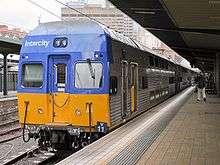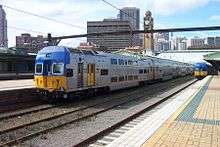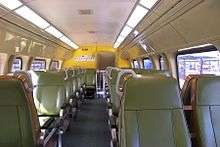NSW TrainLink V set
| V set | |
|---|---|
|
V92 at Sydney Central in the 2005 Intercity livery | |
|
V1 in NSW TrainLink livery in 2013 | |
| In service | 1970-present |
| Manufacturer | Comeng |
| Built at | Granville |
| Constructed | 1970-1989 |
| Number built | 246 |
| Formation | 4 carriages |
| Capacity | 96 seated (driving cars), 112 seated (trailer cars) |
| Operator(s) | NSW TrainLink |
| Depot(s) | Flemington |
| Line(s) served |
Blue Mountains Newcastle |
| Specifications | |
| Car length | 23.968 m (78 ft 8 in) |
| Width | 2.928 m (9 ft 7 in) |
| Height | 4.382 m (14 ft 5 in) |
| Maximum speed | 115KPH (Max operation speed) |
| Weight | 61 t (60 long tons; 67 short tons) |
| Traction system | Mitsubishi |
| Track gauge | 1,435 mm (4 ft 8 1⁄2 in) |
The V sets are a class of Australian electric multiple unit operated by NSW TrainLink in New South Wales. These stainless steel double deck trains operate on Interurban services on the Main Western line to Lithgow and Main Northern line to Hamilton (Newcastle). These trains no longer operate on the NSW Trainlink South Coast Line to Kiama or Port Kembla due to the newer H sets.
History
Orders and Contracts
The V sets were delivered over a 19-year period from 1970.
Series 1 NSWGR Contract 8/68 - Comeng contract 68/11 - specification 2384 - entered service 1970
- DCF8001 - DCF8008 (8)
- DDC9001 - DDC9004 (4)
- DTF9011 - DTF9012 (2)
- DTC9021 - DTC9022 (2)
Series 2 NSWGR Contract 2/76 - Comeng contract 76/3 - specification 2505 - entered service 1977 Oerlikon brake valves. Sigma Blue Light air conditioning. No crew air conditioning. Low dashboard. Coloured fault lights. Mesh Resistor covering on roof.
- DCM8021 - DCM8036 (16)
- DCT9031 - DCT9044 (14)
Series 3
NSWGR Contract 3/80 - Comeng contract 79/5 - specification 2505 - entered service 1982 Davies & Metcalf brake valves. Sigma Blue Light air conditioning. No crew air conditioning. Low dashboard. Coloured fault lights. Mesh resistor covering on roof.
- DIM8037 - DIM8052 (16)
- DIT9101 - DIT9114 (14)
NSWGR Contract 3/80E - Comeng contract 8007 - specification 2505 Davies & Metcalf brake valves. Sigma Blue Light air conditioning. No Crew air conditioning. Low dashboard. Coloured Fault Lights. Mesh Resistor covering on roof.
- DIM8053 - DIM8068 (16)
Series 4 NSWGR Contract 7/82 - Comeng contract 8205 - specification 2505 amended Davies & Metcalf brake valves. Sigma Yellow Light air conditioning. Crew air conditioning installed. Low dashboard (High from DIM8090). Text fault lights. Mesh resistor covering on roof.
- DIM8069 - DIM8092 (24)
- DIT9115 - DIT9138 (24)
Series 5 A continuation of the contract for Series 4, these cars were fitted with Chopper controls. NSWGR Contract 7/82 - Comeng Contract 8205 - Specification 2505 CH Davies & Metcalf brake valves. Sigma Yellow Light air conditioning. Crew air conditioning installed. High dashboard. Text fault lights. Slatted covering on roof over Chopper equipment.
- DJM8093 - DJM8108 (16)
- DIT9139 - DIT9154 (16)
Series 6 NSWGR Contract 3/86 - Comeng contract 8601 Davies & Metcalf brake valves. Sigma Yellow Light air conditioning. Crew air conditioning installed. High dashboard. Text fault lights. Slatted covering on roof over Chopper equipment.
- DJM8109 - DJM8123 (15)
- DIT9155 - DIT9169 (15)
Series 7 NSWGR Contract 7/87 - Comeng contract 8701 Davies & Metcalf brake valves. Sigma Yellow Light air conditioning. Crew air conditioning installed. High dashboard. Text fault lights. Mesh covering on roof over Chopper equipment.
- DJM8124 - DJM8138 (15)
- DIT9170 - DIT9184 (15)
Series 8 The final series. NSWGR Contract 1/88 - Comeng contract 8801 Davies & Metcalf brake valves. Yellow painted interior. Sigma Yellow Light air conditioning. Crew air conditioning installed. High dashboard. Text fault lights. Mesh covering on roof over Chopper equipment. Power operated vestibule doors (Now all isolated). Wide body side fluting, similar to that used by A Goninan & Co on their S sets. Spring Parking Brake in trailer car (Now all disconnected). Semi-permanently coupled 2 car blocks.
- DKM8139 - DKM8145 (7)
- DKT9185 - DKT9191 (7)
First batch (DCF, DDC, DTF & DTC)
In July 1968 the New South Wales Government Railways placed an order for the first batch 16 cars with Commonwealth Engineering.[1] The first 4 cars debuted on the Sydney to Gosford route on 22 June 1970, targeted as F111.[2] All 16 cars were in operation by September 1970.[3]
These cars had many similar features to the later-built cars, including the one-piece moulded glass reinforced plastic end in royal blue & grey livery (earning them the Blue Goose nickname), semi-automatic doors, electronically controlled brakes and double-glazed windows. They had a different style of headlight and interior lighting to subsequent builds.
There were:
- 8 Power Cars - DCF 8001–8008 - Economy Class
- 4 Driving Trailer Cars - DDC 9001–9004 - 1st Class upper deck, Economy Class other seats
- 4 Trailer Cars - DTF 9011-9012 - Economy Class; DTC 9021–9022 - 1st Class upper deck, Economy Class other seats
The configuration of these cars was unsuccessful. The cars were fitted with AEI equipment, and the electrical equipment was split between the power and trailer car. The cables were not able to provide the power needed to operate the train as proposed. This resulted in many failures of the train to operate and also failures in the air-conditioning system.
One class travel was introduced in September 1974, so the seating was all economy class. This led to the refurbishment of the DDIU sets with the original luggage racks above the seating in the single deck section being removed. During this time the sets were targeted as U sets, the plates used on the single deck interurbans.
In the early 1980s it was decided to convert these to trailer cars hence 16 power cars were ordered with no matching trailers. Between March and December 1982 the cars were rewired at Electric Carriage Workshops, and the driver compartments removed and replaced by passenger toilets and luggage space. The reinforced plastic ends remained, albeit with the blue removed.[1]
The cars were subsequently renumbered:
- DCF 8001–8008 > DMT 9201–9207 (7 cars remained after writing off DCF 8004)
- DDC 9001–9004 > DDT 9208–9211
- DTF 9011–9012 & DTC 9021–9022 > DFT 9212–9215
In 2002 these sets were withdrawn and scrapped following the discovery of rust in the steel frames.
Second batch (DCM & DCT)
From October 1977 the second batch began to enter service, with many differences from the first batch. The electrical equipment was all mounted on the power car, using Mitsubishi Electric equipment; they had stainless steel underframes; were fitted with vacuum retention toilets, and had gold as opposed to green tinted windows. These cars were the first of the V sets, with the V showing that they were installed with vacuum retention toilets. They operated separately from the 1970 cars, as the two types were not compatible with each other.[1]
The cars built were:
- Power Cars - DCM 8021–8036
- Driving Trailer Cars - DCT 9031–9044
The driving trailers were not used that much, due to driver complaints about an uncomfortable "kick" when the power car started to push the trailer. The controls in the DCTs were gradually stripped and replaced defective ones on the DCMs. In 1990 DCT 9034 was refurbished by CityRail as a lounge car with lounge chairs and a kitchen for use as a charter car named Contura.[4] It wasn't a success, not helped by poor marketing, and it was rebuilt as a conventional trailer (without controls) in 2000 and renumbered DET 9216 During the Citydecker refurbishment carried out by A Goninan & Co in the 1990s, DCT 9031-9036 had their driver controls reinstated and were recoded as DTDs allowing CityRail to introduce The River a two-car service from Wyong to St Marys. At the same time the DCMs were refurbished, receiving destination indicators and ditchlights. The refurbishment also saw the installation of air-conditioning in the driver's cabs of the DCMs, their lack of air-conditioning had a union ban preventing them being used as leading cars since 1995.[5] DCM 8032–8036 were modified to have wheelchair seating, and recoded as DTMs. The DCMs that had destination indicators eventually had them removed and replaced with a metal blanking plate, after a decision not to use them on Interurban services. Some were withdrawn in 2011.
Third batch (DIM & DIT)

From May 1981 DIM Power Cars and DIT trailers started to be delivered. These cars had increased seating compared with the DC series, up from 88 to 96 for the power cars, and from 92 to 112 for the trailers.
The cars built were:
- Power Cars - DIM 8037–8092
- Trailer Cars - DIT 9101–9184
DIM 8037-8068 and were the last cars to be delivered with the Blue Goose moulded fibreglass ends, cream & wood veneer interiors and green seats.
DIM 8069-8092 were built with a white moulded fibreglass end incorporating the State Rail Authority's corporate colours of red, orange and yellow, yellow interiors, newer air conditioning technology and ditchlights. These can be distinguished from the earlier DIMs by the air-conditioning grille cover.
DJM and the rest of DIT cars

Advancements in technology saw a thyristor chopper system fitted to the next batch of power cars, coded DJM. The chopper cars gave a smoother and quieter ride. The chopper cars can be distinguished from the earlier camshaft cars by a large open grille at the pantograph end of the power car, and by different hatch coverings over the driver's side of the power car. DJM 8123–8137 had even larger open grilles on the pantograph end. DJM 8101 had its Candy livery moulded fibreglass end repainted into CityRail blue and yellow in 1990 to form a special set, with the commemorative wording "celebrating 20 years of double-deck intercity services to Gosford" applied near the driver's cab window. In 2009 DJM 8101's front was repainted into standard Intercity livery.
Final batch (DKM & DKT)



The final V sets were introduced in 1989, and they were the last carriages to be built by Comeng's Granville factory. These cars were coded DKM and DKT and are permanently coupled. There were several changes: the cars were finished in corrugated steel, instead of the previous inserted Budd fluting. Seating had separate seat backs. Instead of the push-pull doors inside the previous V sets, the DKs were fitted with an electronically operated vestibule door, and no door was installed at the gangway. The State Rail Authority wanted to order an extra 50 but funding was not available.[6]
Overhauls
During 1993 the distinctive gold tinted windows were replaced by charcoal ones.[7] Starting in May 1995 the earlier carriages were overhauled by A & Co, Broadmeadow as part of the CityDecker program. This saw the DCMs receive driver's cab air conditioning, destination indicators and ditchlights where not already fitted.[8][9] The fibreglass end was repainted grey and yellow. This was later changed to blue and yellow.
Eventually all cars were put through the program with those with yellow interiors being refurbished in the same cream interior with green seats style as the older cars.
On 1 July 2013, a refurbishment of the remaining 200 cars was announced as part of the NSW TrainLink and Sydney Trains restructure and branding. The refurbishment most notably includes new carpets and seat covers themed in 'Bush Plum'. The external livery of the trains are also changed to a grey, red and yellow scheme.[10]
In service
When introduced, the V sets operated interurban services from Sydney Central on the Main Northern line to Gosford and on the Main Western line to Mount Victoria. It wasn't until the Ten Tunnels west of Clarence were lowered in the 1978 that they were able to operate to Lithgow.
Following the extension of the electrified network, their sphere of operation was extended to Wyong (April 1982), Newcastle (June 1984), Port Kembla (February 1986), Dapto (January 1993) and Kiama (November 2001). From January 2012, V sets ceased operating South Coast services. In June 2015, retired cars 8038-9031-9040-8040 were returned to service as V27
Accidents

- DCM 8027 was rebuilt after an accident at Katoomba
- DCF 8004 – on 16 January 1976, a six-car set broke down at Glenbrook, locomotive 4623 struck the rear car killing one passenger and injuring several others
- DCM 8030 was written off after an accident near Emu Plains in September 1985[11]
- DIM 8048 was written off after an accident at Springwood in September 1987[8]
- DJM 8107 was written off after an incident at Lawson in November 1989[8]
- DIM 8037 was written off after an accident at Katoomba in January 1990[7]
- DIM 8060 was written off after the Cowan rail accident in May 1990
- DIM 8067 on 2 December 1999 collided with the rear car carrier of the Indian Pacific in the Glenbrook train disaster rebuilt as DIM 8020
- DCM 8028 was written off after being crushed by falling trees at Medlow Bath in July 2011[12]
- V40 and V48 collided with each other at Mount Victoria in July 2015. Two cars of V40 (DKM 8144, DKT 9190) and V48 (DJM 8113, DIT 9147) were withdrawn for repairs and have since returned to service
Withdrawal
The remaining 15 original series cars were withdrawn in late 2005 due to corrosion in the underframes, these cars had low-carbon mild steel underframes instead of the stainless steel used on later batches. DMT 9204 was subsequently destroyed in an emergency services training exercise on 25 November 2008.
In January 2011 an additional 25 Oscar H set cars were ordered to replace the 1977 batch of V sets.[13] However some remain in service and were put through the refurbishment programme in 2014.
In May 2014, the State Government announced its intention to purchase 520 new carriages for the NSW TrainLink intercity network, with deliveries to commence in 2019. These new trains will replace the V sets.[14]
Y sets
Six cars from the third batch have been converted into test trains to test/trial the Automatic Train Protection system and the Digital Train Radio System across the electrified network. DJMs 8121, 8127, 8128 & 8134 and DITs 9127 & 9131 have been formed into two sets numbered Y1 and Y2.[15] They are fitted with computers and test equipment, several CCTV cameras and small kitchens in the trailer cars.
Gallery
 Upper deck of a V set carriage with Intercity Livery
Upper deck of a V set carriage with Intercity Livery Vestibule seating area looking towards the door to exit on a light wooden model car with an Intercity Livery
Vestibule seating area looking towards the door to exit on a light wooden model car with an Intercity Livery Vestibule seating area looking towards stairs to upper and lower decks
Vestibule seating area looking towards stairs to upper and lower decks Some carriages have seats removed in the vestibule to make room for wheelchairs
Some carriages have seats removed in the vestibule to make room for wheelchairs Carriage with widened door to vestibule to allow wheelchairs to enter seating area
Carriage with widened door to vestibule to allow wheelchairs to enter seating area
References
- 1 2 3 "Rostering Electric Interurban Trains" Railway Digest January 1985 page 2
- ↑ "Double-Deck Interurbans in NSW" Railway Digest June 2000 page 49
- ↑ Dunn, John (2010). Comeng: A History of Commonwealth Engineering Volume 3: 1967-1977. Kenthurst: Rosenberg Publishing. pp. 57–76. ISBN 9781877058905.
- ↑ "CityRail launches lounge car" Railway Digest December 1990 page 424
- ↑ "A Review of Electric Multiple Unit (EMU) Rolling Stock" Railway Digest March 1995 page 36
- ↑ "New Interurban Cars" Railway Digest March 1988 page 83
- 1 2 "A Review of Electric Multiple Unit (EMU) Rolling Stock" Railway Digest March 1994 page 36
- 1 2 3 "A Review of Electric multiple (sic) Unit (EMU) rolling stock" Railway Digest October 1995 page 28
- ↑ "A Review of Electric Multiple Unit (EMU) rolling stock" Railway Digest March 1996 page 34
- ↑ "NSW Trainlink to deliver dedicated service for Intercity and Regional customers" Transport for NSW, 1 July 2013
- ↑ "Emu Plains Collision" Railway Digest November 1985 page 330
- ↑ Strong winds cause chaos Sydney Morning Herald 6 July 2011
- ↑ "25 more Oscar carriages on the way". CityRail. 18 January 2011.
- ↑ NSW Government to invest $2.8 billion in new intercity trains, making all trains air-conditioned Transport for New South Wales 8 May 2014
- ↑ Movement of "Y" Sets consisting of converted Double Decker Intercity "V" Sets between Maintrain, Auburn and Flemington, RailCorp, 9 February 2012
Further reading
- Beckhaus, John; Halgren, Stephen (2007). "Sydney's Electric Trains". Australian Railway Historical Society NSW Division. ISBN 978-0-9757870-8-3.
External links
-
 Media related to NSW TrainLink V sets at Wikimedia Commons
Media related to NSW TrainLink V sets at Wikimedia Commons - Technical diagrams and specifications
